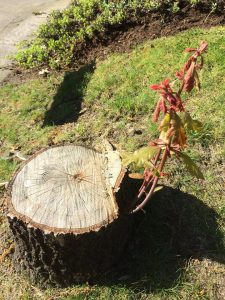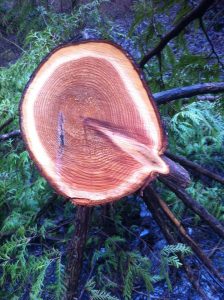One day last year I went out for a jog at Shoreline park in Port Moody, British Columbia and ran past a fallen tree. Ok, trees fall all the time in the forest. But luckily the municipal workers made a nice clearance cut exposing one of the branch attachments. See the picture below.
Strong attachment
What do you notice? Do you see how the branch on the right is firmly attached? It’s solidly in place because it belongs there. It’s a true branch developed in a socket of overlapping wood tissue. So I stopped running and snapped a few photos. Then, after I resumed running I thought about my arborist friend’s tree lecture.
Paul Buikema is one of my tree mentors and his lectures are to be recommended. He related one story, complete with slides, showing a gorgeous deciduous tree with large leaves. I totally forgot the exact species. Paul was asked to prune it so he climbed inside. Then, horrified, he realized that all of the branches he was stepping on were pseudo-branches.
Weak attachment
The tree had been topped in the past and the branches Paul was standing on pushed out from apical meristems. Basically, when you top a tree, the buds nearest to the top push out and develop into branches. These are pseudo-branches, not real, strongly attached branches. They are attached only in the outermost layers of the parent branches and prone to failure.
Of course, Paul didn’t push his luck and bailed out of the project. It just wasn’t safe for him to stay there.

This is an illegally cut pin oak (Quercus palustris). Note the three shoots. They will never be as strong as normal branches.
This is an extreme example but it illustrates my point. This pin oak (Quercus palustris) was cut down illegally. Now look at the shoots. They will never be as strong as normal branches. Of course, I love the resilience of this oak. It’s pushing back after getting abused.
Don’t top trees
So here again we have one of the main reasons to not top trees. As the new pseudo-branches develop into big branches they can snap in wind or ice storms. This is one of the arguments arborists use to talk residents out of tree topping. Insisting on tree topping means that they accept future failure liability. That might scare them off.
If you want to read more about tree topping click here.





